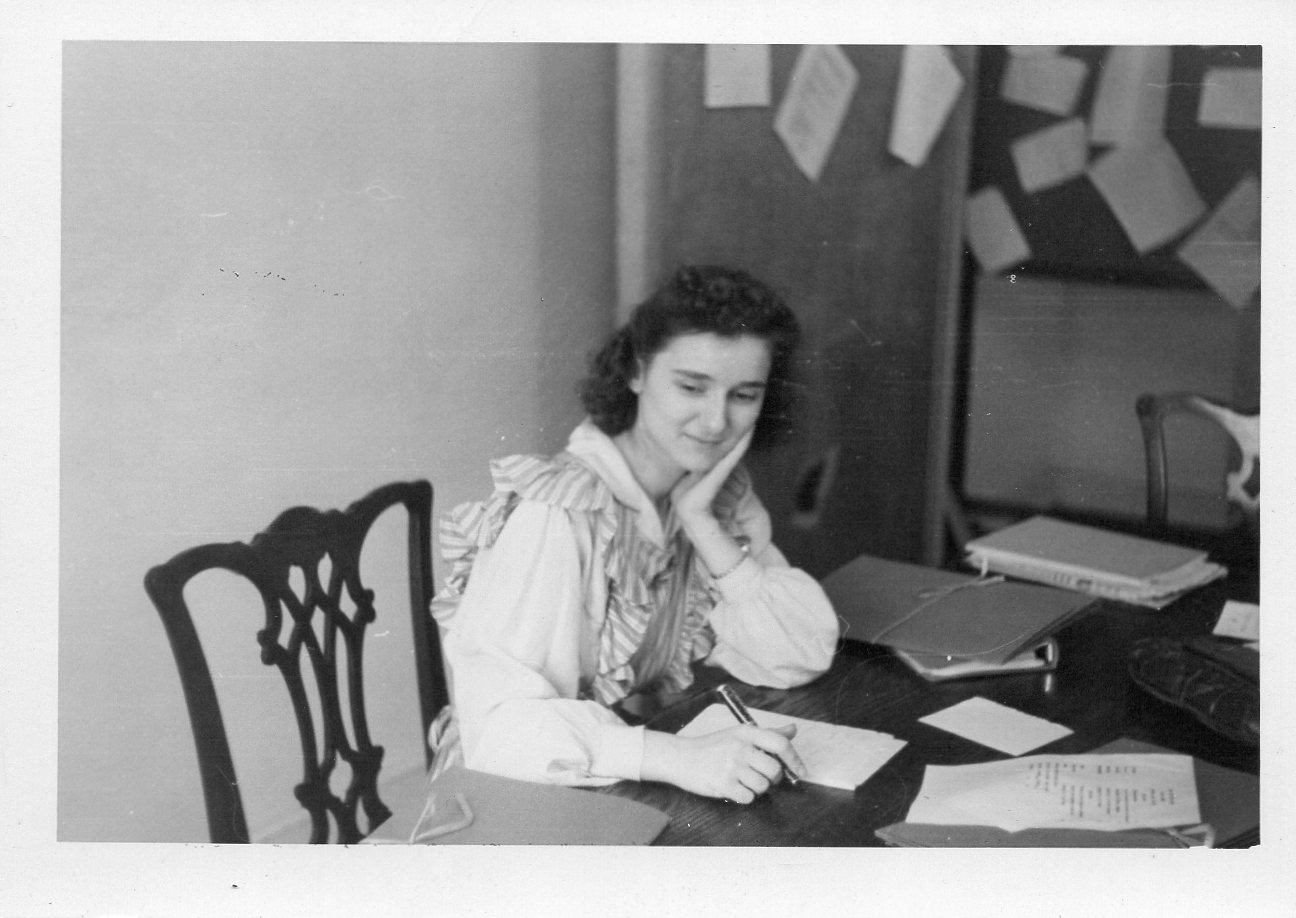 Mary (Kranos) Rubio (LAS 1943) was a graduate student in Spanish in 1943 and 1944. She worked as a part-time secretary to the head of the department, John van Horn, with whom she shared an office in 214 Lincoln Hall.
Mary (Kranos) Rubio (LAS 1943) was a graduate student in Spanish in 1943 and 1944. She worked as a part-time secretary to the head of the department, John van Horn, with whom she shared an office in 214 Lincoln Hall.
She has provided invaluable memorabilia of the department and the University of Illinois during WWII. The Mary (Kranos) Rubio Archive documents as well the Enrique Rodríguez Fabregat stay in the department, as a Visiting Professor from Uruguay who later served as a diplomat at the United Nations.
Memorabilia kindly provided by Thalia Rubio and Benita Rubio.
1. MARY (kranos) RUBIO'S PERSONAL RECOLLECTIONS AND MEMORABILIA
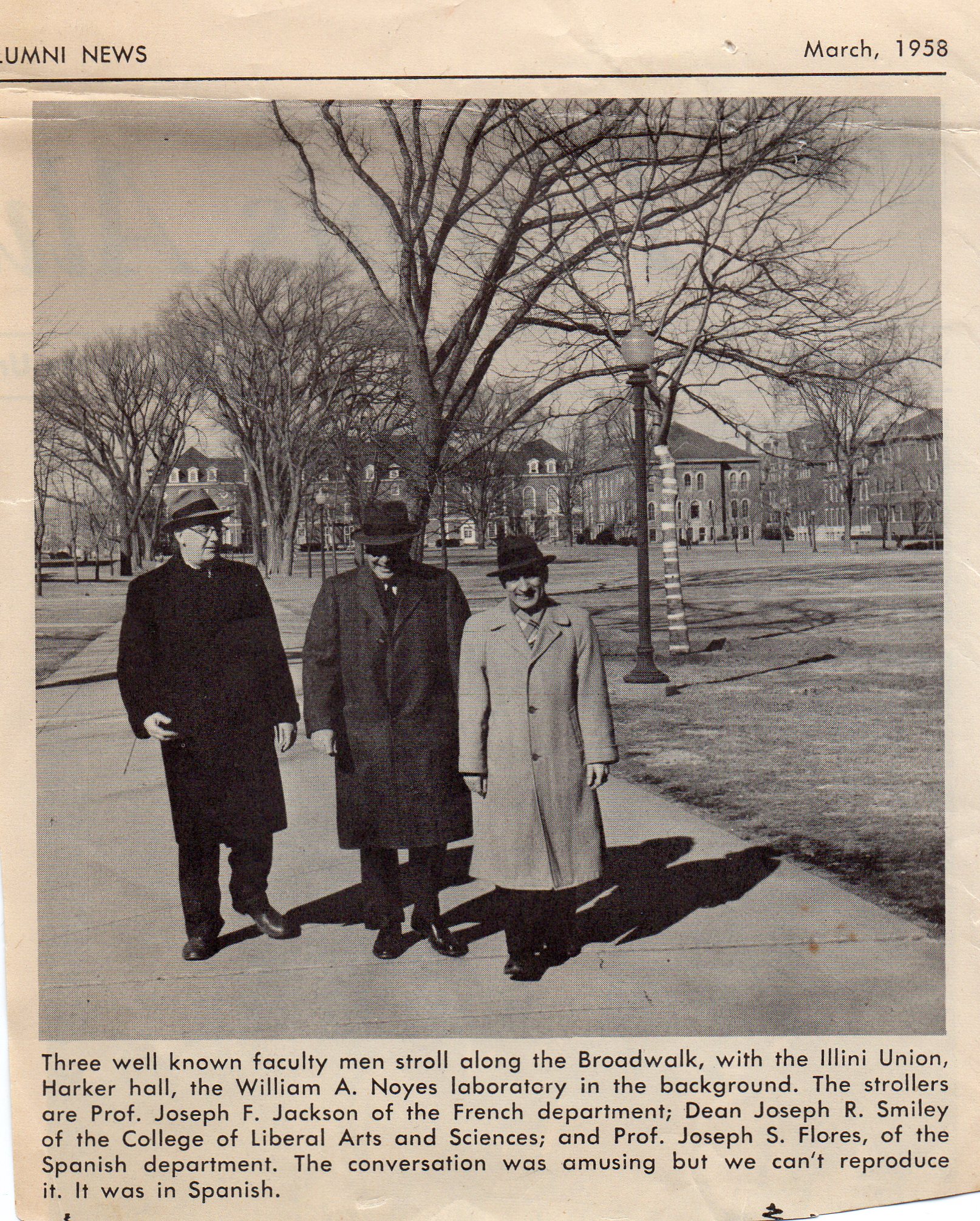
Newspaper clipping from the alumni newspaper (Alumni News, March, 1958) showing Professor Joseph Flores with Professor Joseph Jackson of the French department and Dean Smiley of the College of Liberal Arts and Sciences. Joseph Flores was from a city in Ohio and taught at the University of Illinois in the 1940s.
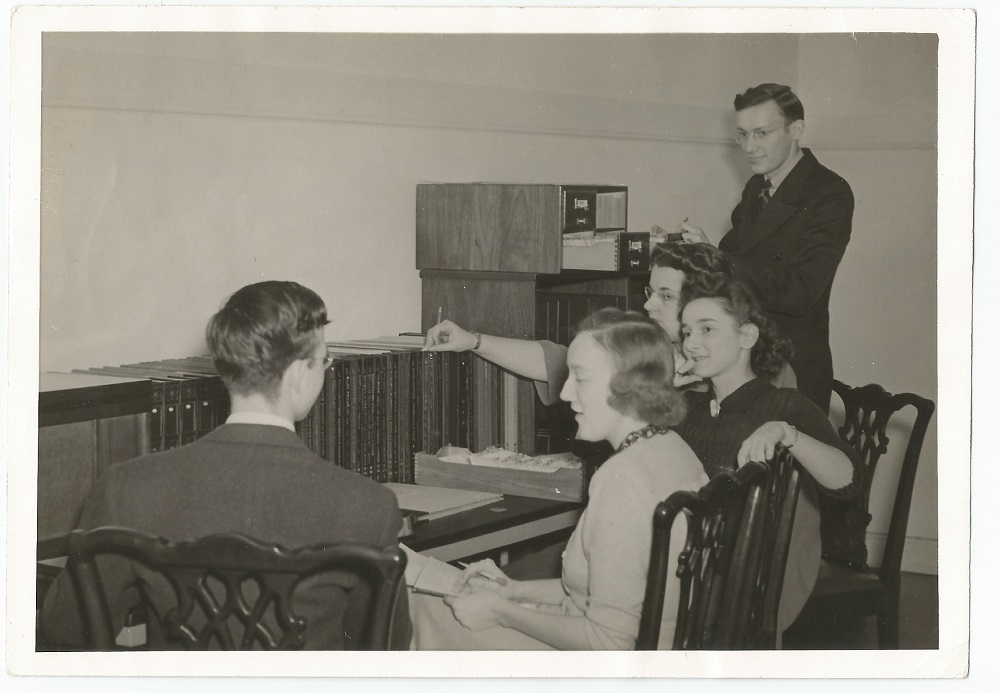 Feb. 18, 1942. The Music Committee. Mary (Kranos) Rubio is third from left; also in the photo are William Lyn and Eleanor Stoskus. Eleanor Stoskus may have been studying journalism; she went on to a career in broadcast radio. This committee was responsible for selecting and playing music to play over the loudspeakers in the Union Building Lounge. They played music on the record players shown in the photograph, with two or three standing speakers; it was a precursor to college radio. The committee worked in 319 Union Building,where they kept the record albums, developed the programs, and rehearsed. In the group photo are a phonograph, record albums, files, and more record albums.
Feb. 18, 1942. The Music Committee. Mary (Kranos) Rubio is third from left; also in the photo are William Lyn and Eleanor Stoskus. Eleanor Stoskus may have been studying journalism; she went on to a career in broadcast radio. This committee was responsible for selecting and playing music to play over the loudspeakers in the Union Building Lounge. They played music on the record players shown in the photograph, with two or three standing speakers; it was a precursor to college radio. The committee worked in 319 Union Building,where they kept the record albums, developed the programs, and rehearsed. In the group photo are a phonograph, record albums, files, and more record albums.
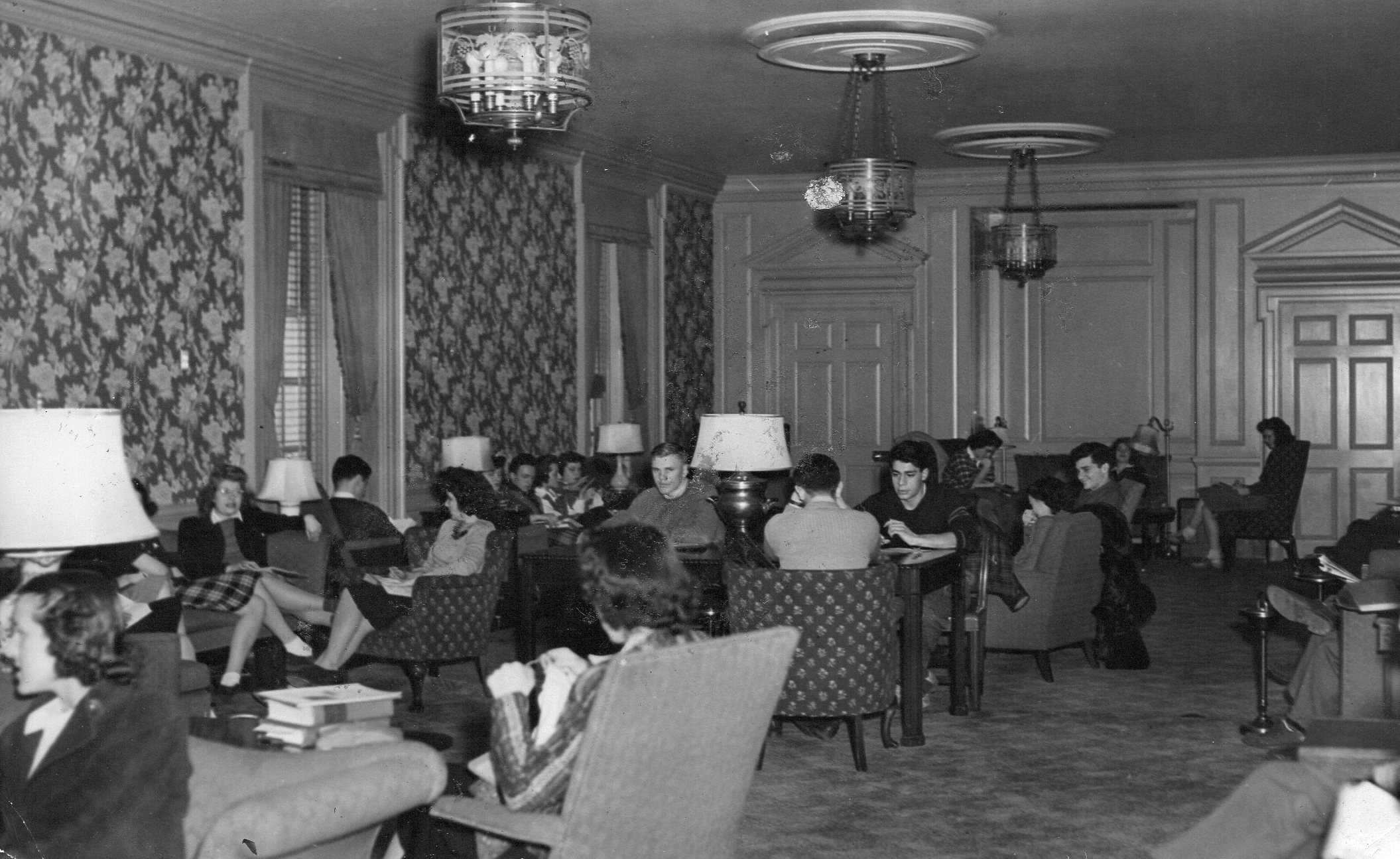
Union Building lounge during the first month the building opened. The photo was taken by Bob Holley, a student who was the official University of Illinois photographer. In 1968, Robert Holley shared a Nobel Prize in medicine and physiology for his research on the genetic code.
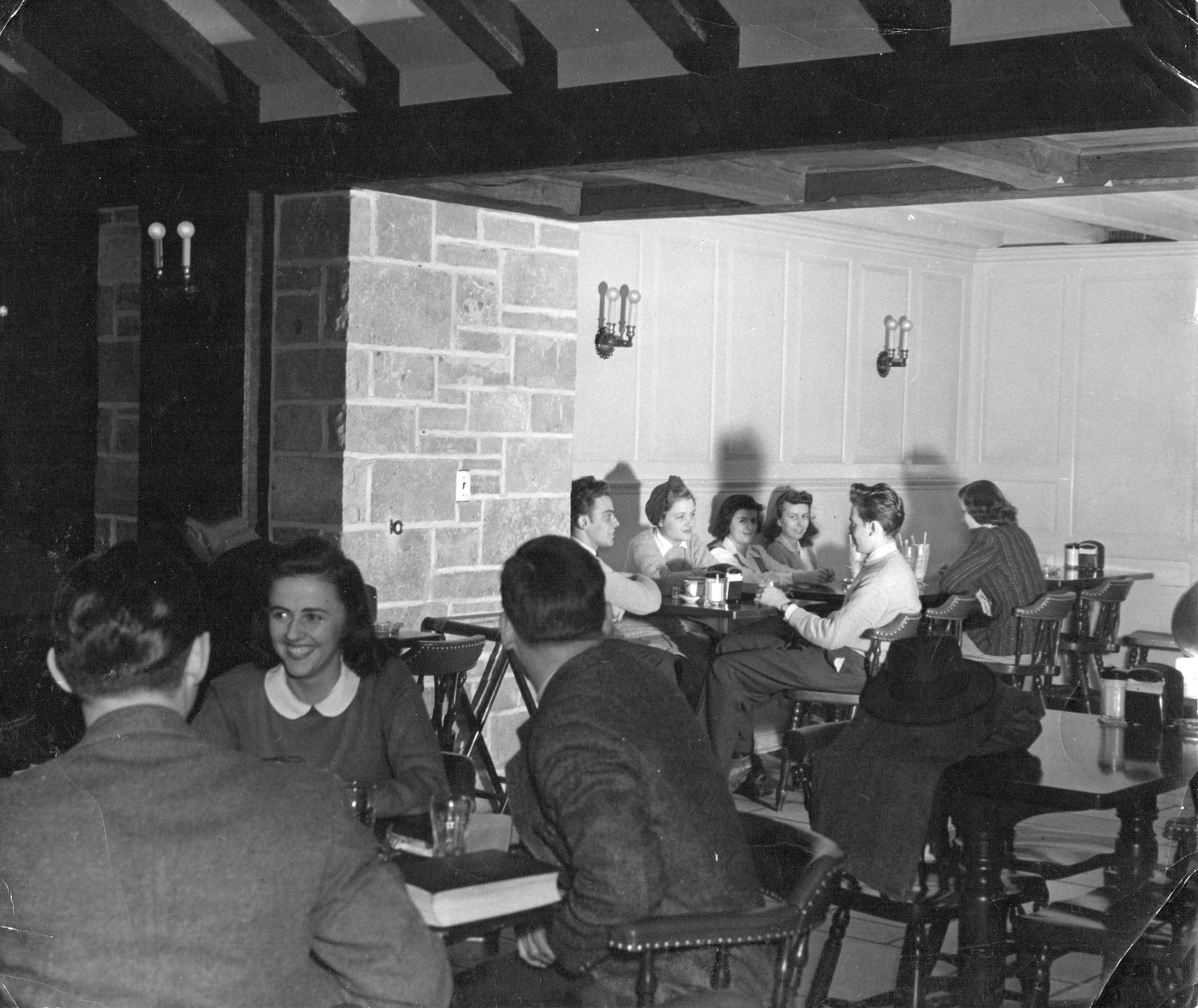
Tavern of the Union Building (in the basement) when the building was new. At the back table are Marte landis in a bandana and the Hesser twins. They were among the European emigres at the University of Illinois during wartime. This group included American and diplomatic families that had to vacate Europe during the war; the students were raised in Europe but they had to leave.
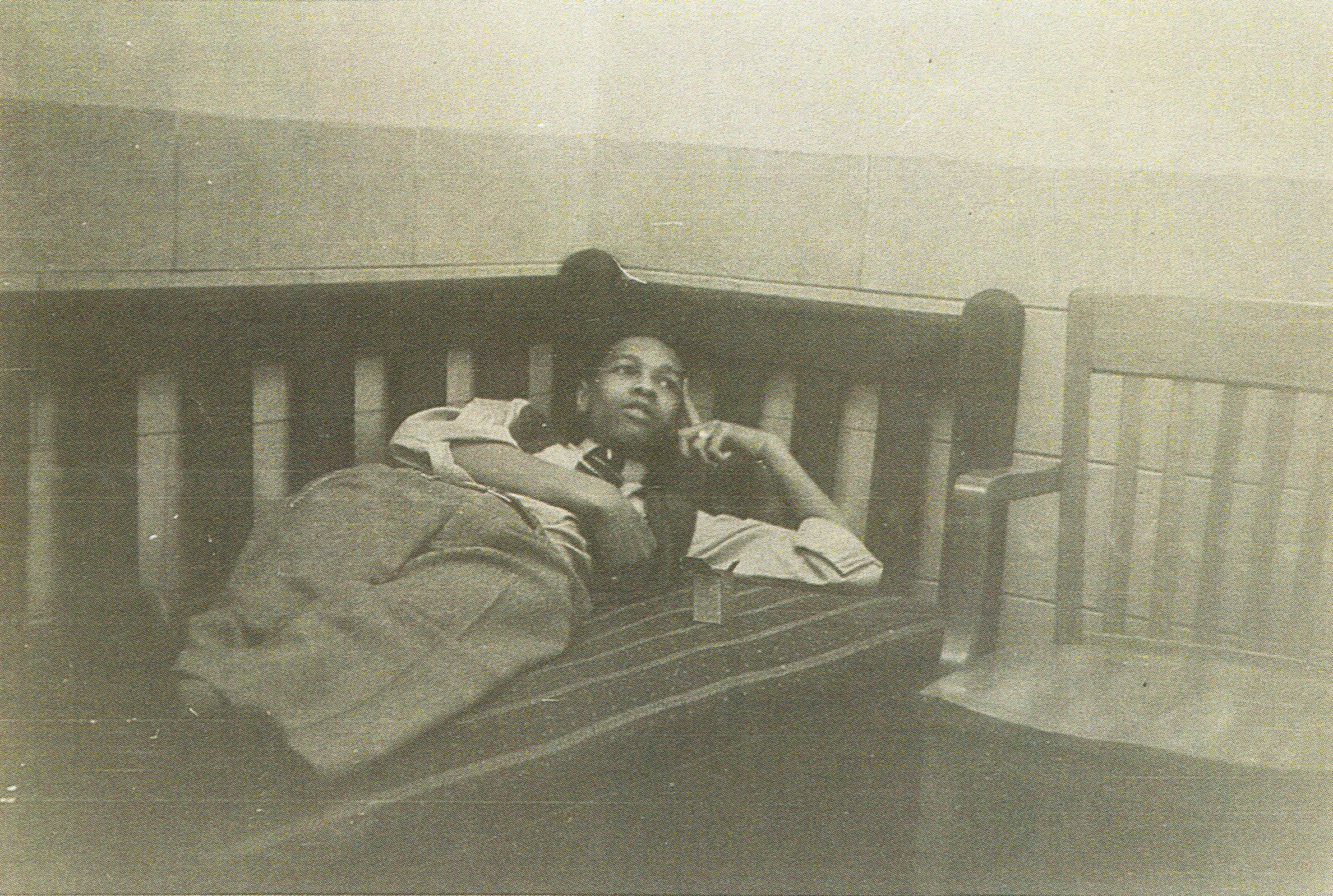
Bob Claybrooks (class of 1943), a native of Chicago. He was on the Music Committee. Mary (Kranos) Rubio says that Bob socialized with them in the Union Building, during a time when African-Americans did not have ready access to coffee shops the way the rest of the students did. Day's Coffee Shop did not serve African-American customers, although Kammerer's did. The Union Building was a godsend for African-American students; they couldn't be excluded from a government building. Robert Claybrooks went on to be one of the first African-Americans in the newsroom of The New York Times.
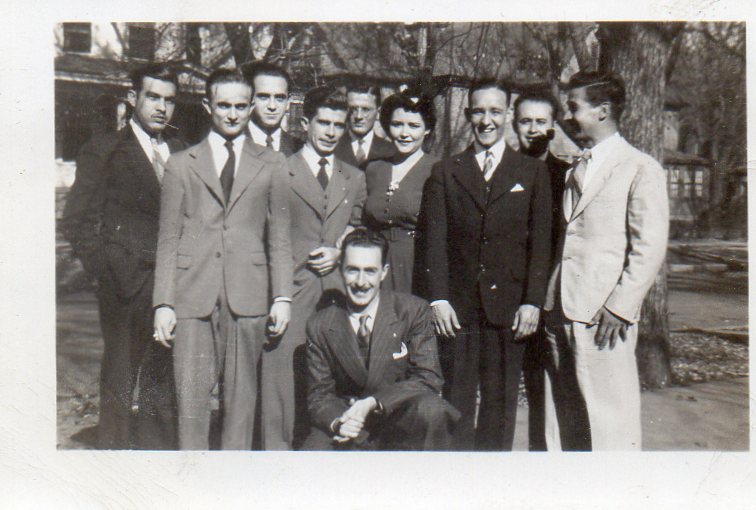
Men from the Cosmopolitan Club, a men's residence across the street from Day's Coffee Shop. Most, if not all, residents were upperclassmen. Residents were foreigners, and most, if not all, were Spanish-speaking. Mary (Kranos) Rubio thinks that the Cosmopolitan Club was on South Fifth Street, half a block from the quadrangle. Students in the photo are Escomel, Zambrano, Muguerza, Ortiz, Rodríguez, and Ferreira.
2. STUDENT PLAYS
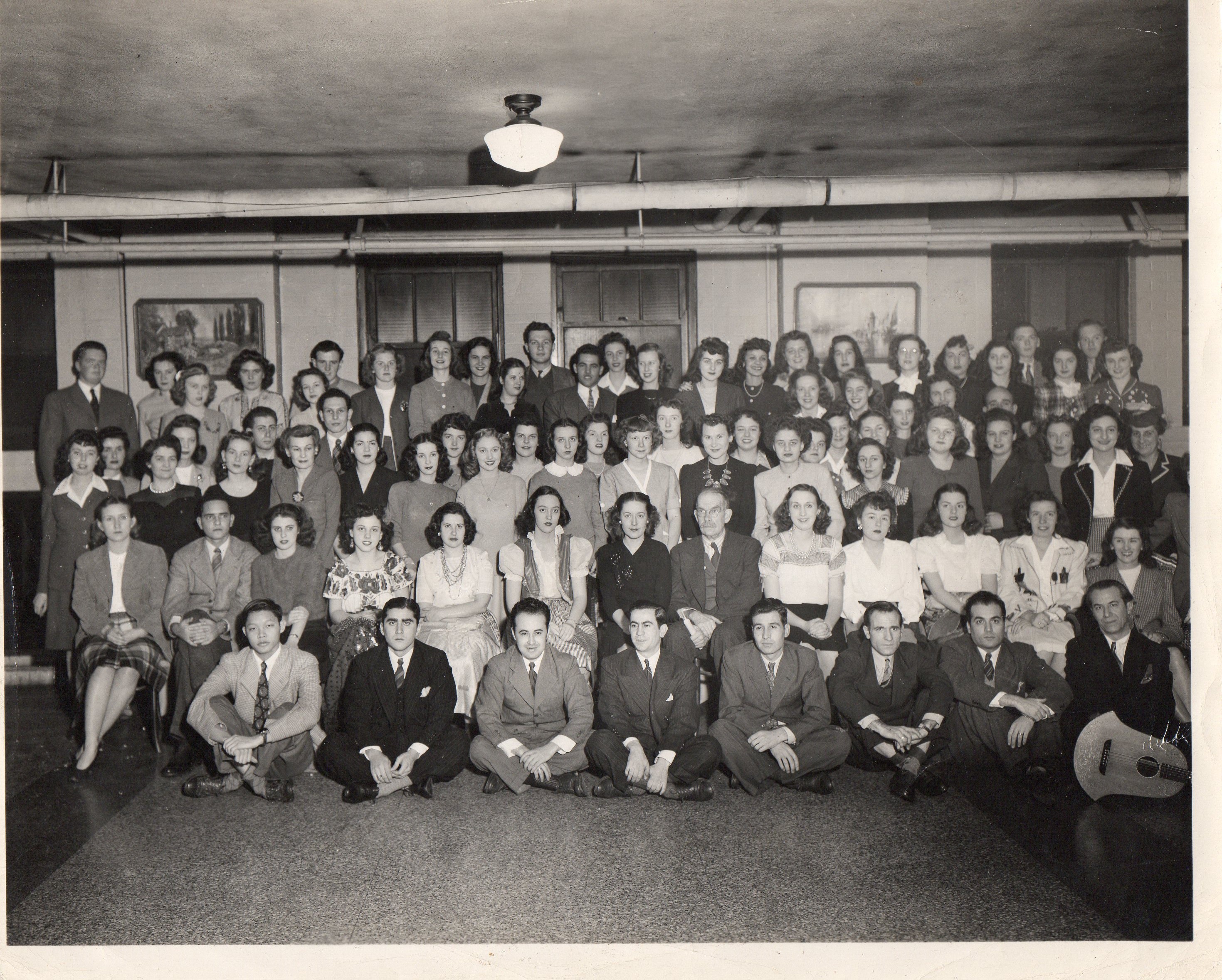 The Spanish club 1940-42, when Professor Hamilton was department head. Arthur Hamilton is eighth from left in the photo. Renato Rosaldo is second from right. Joseph Flores is third from right. Transportation was restricted because of the war; for those from South America it was impossible to get home.
The Spanish club 1940-42, when Professor Hamilton was department head. Arthur Hamilton is eighth from left in the photo. Renato Rosaldo is second from right. Joseph Flores is third from right. Transportation was restricted because of the war; for those from South America it was impossible to get home.
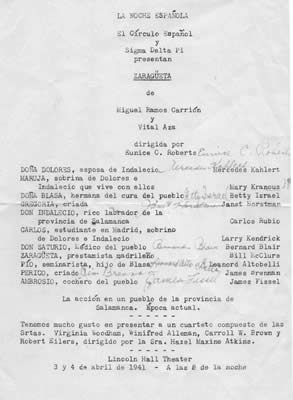
Playbills of student productions featuring Mary (Kranos) Rubio and her husband Carlos Rubio, as well as university professors Renato Rosaldo and Joseph Flores.
El pelo de la dehesa, from the series "La Noche Española" (April 5, 1939)
Le médecin malgré lui by Moliere and L'Anglais Tel Qu'on Le Parle by Tristan Bernard, (Lincoln Hall Theater, March 13, 1941)
Two copies of playbills for Zaragüeta, from the series "La Noche Española" (Lincoln Hall Theater, April 3 and 4, 1941). One copy is autographed (in green ink) by cast members.
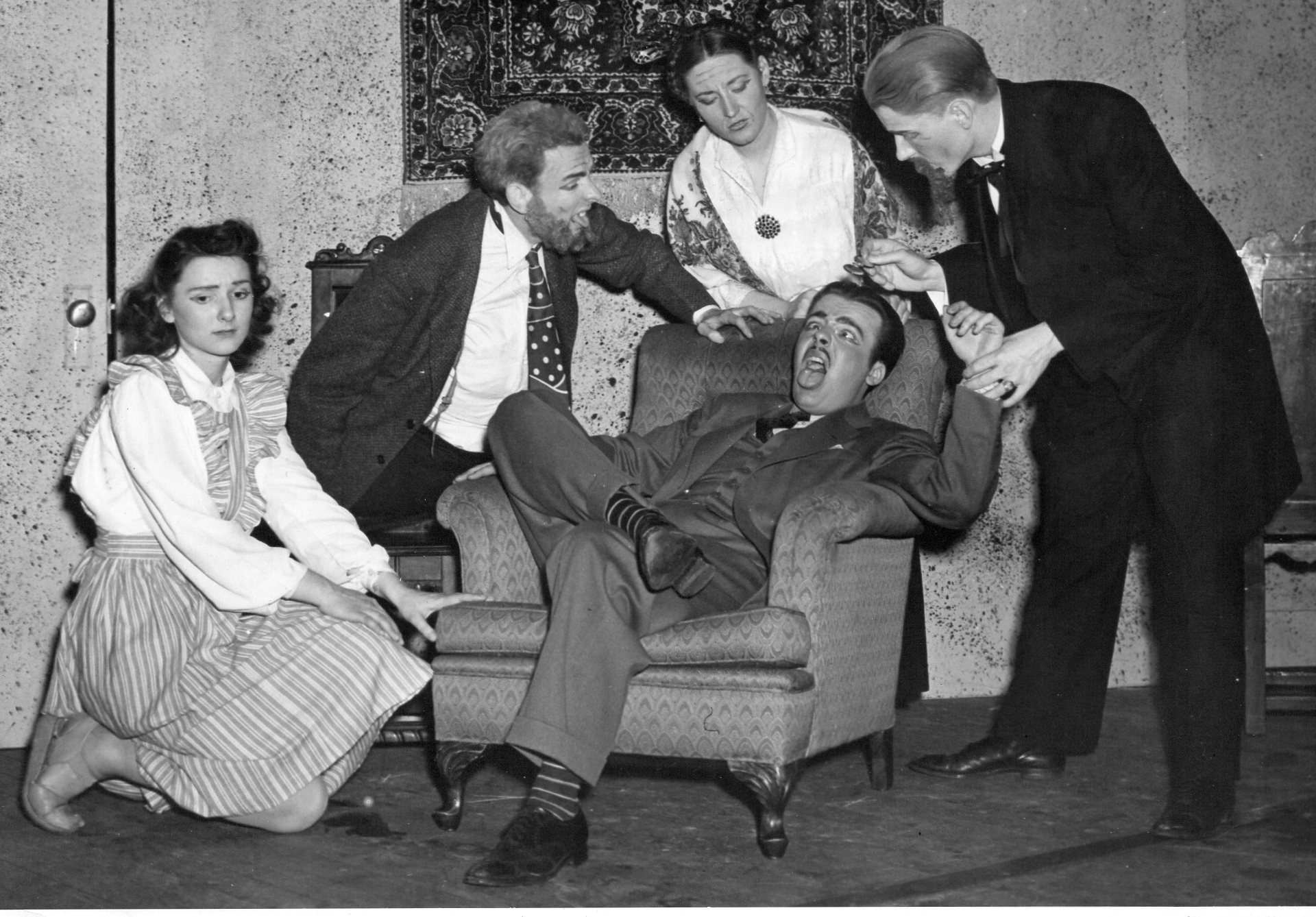
Zaragüeta play; Mary (Kranos) Rubio is wearing a pinafore, and the actor with the thick beard is her husband Carlos Rubio (class of 1941). Photographs by Ben Parker from the Evening Courier, who was the professional photographer for Zaragüeta.
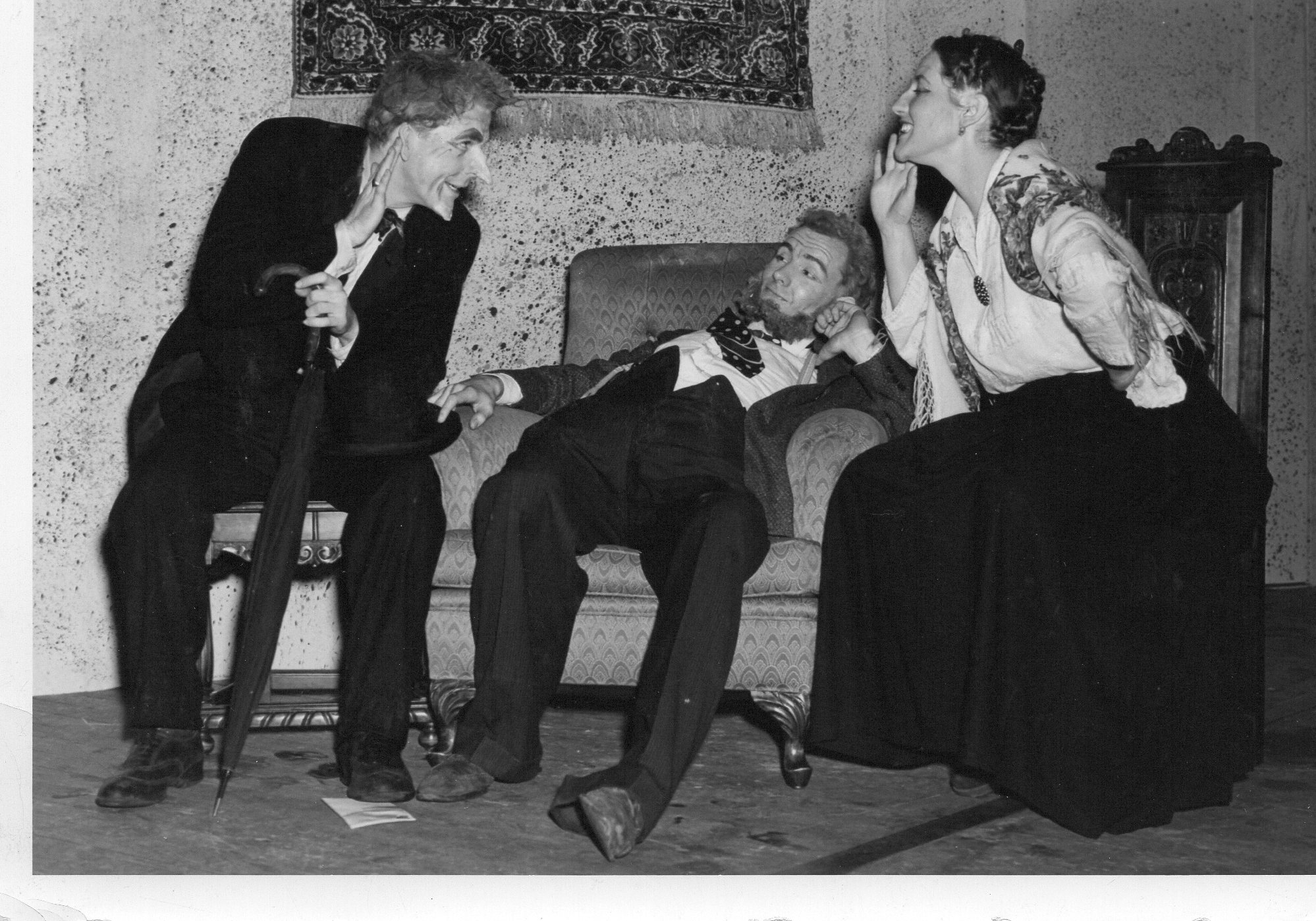
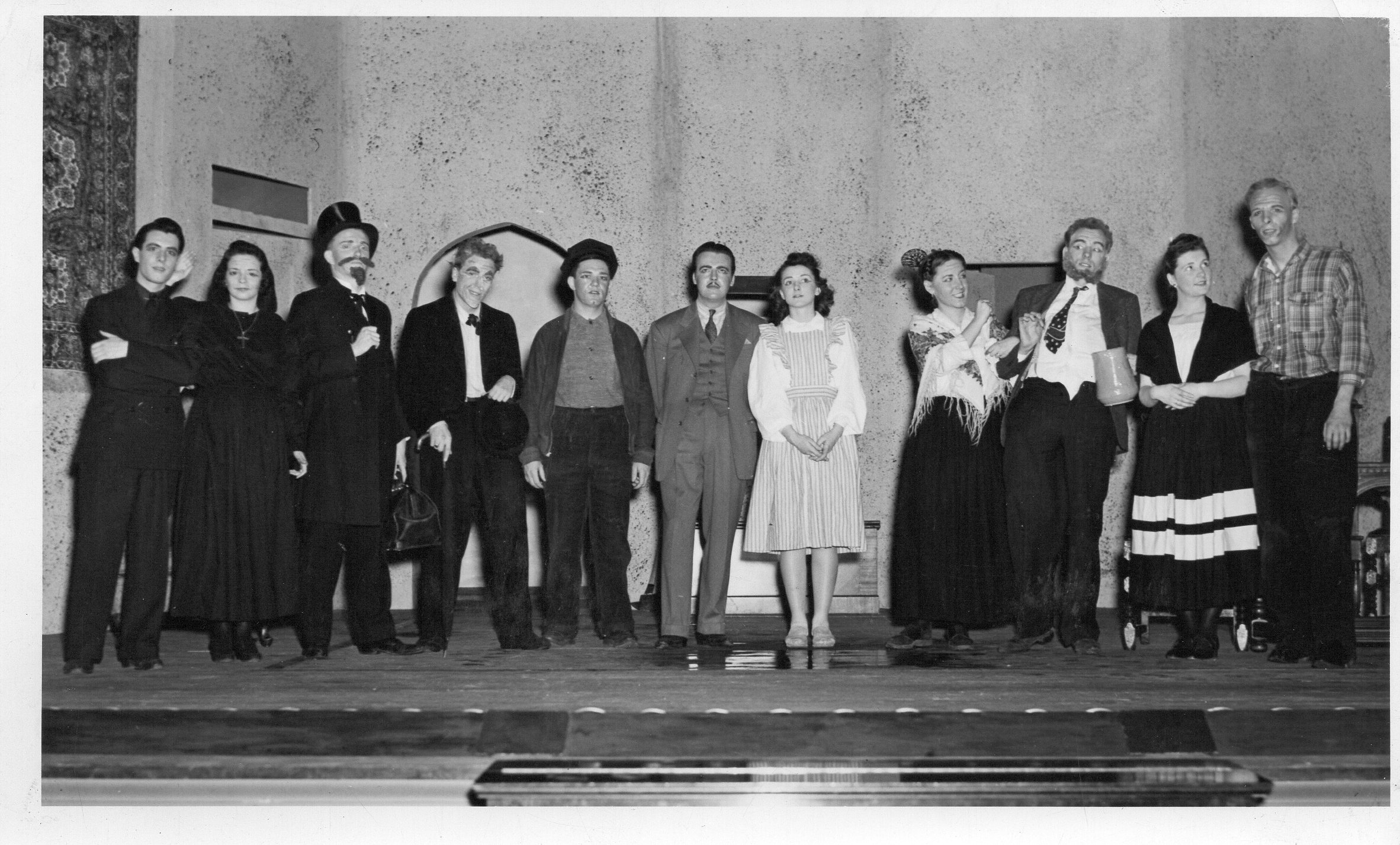
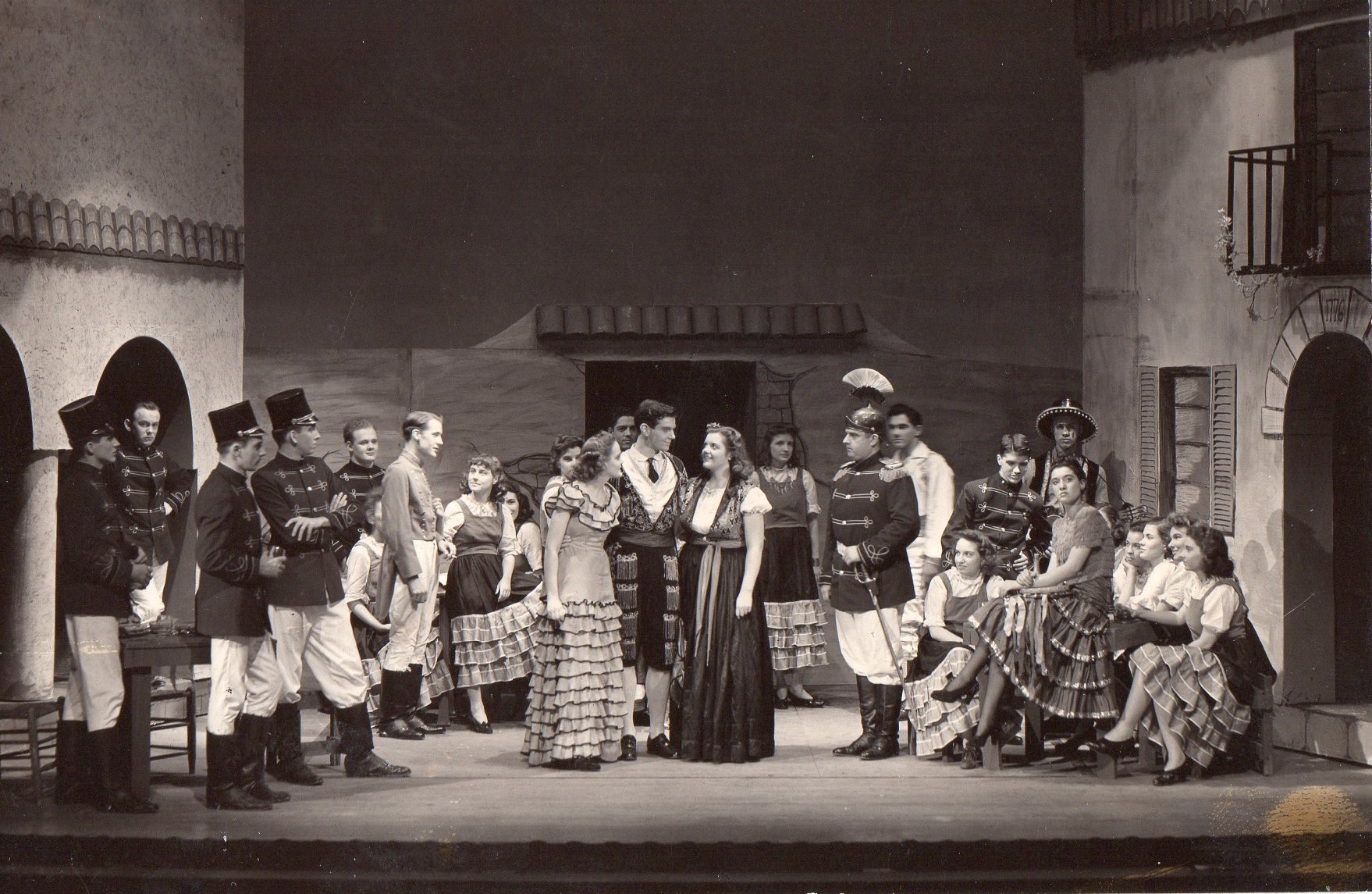 Student production of Carmen by Georges Bizet, with Carmelita Lowry in the cast.
Student production of Carmen by Georges Bizet, with Carmelita Lowry in the cast.
3. ENRIQUE RODRÍGUEZ FABREGAT
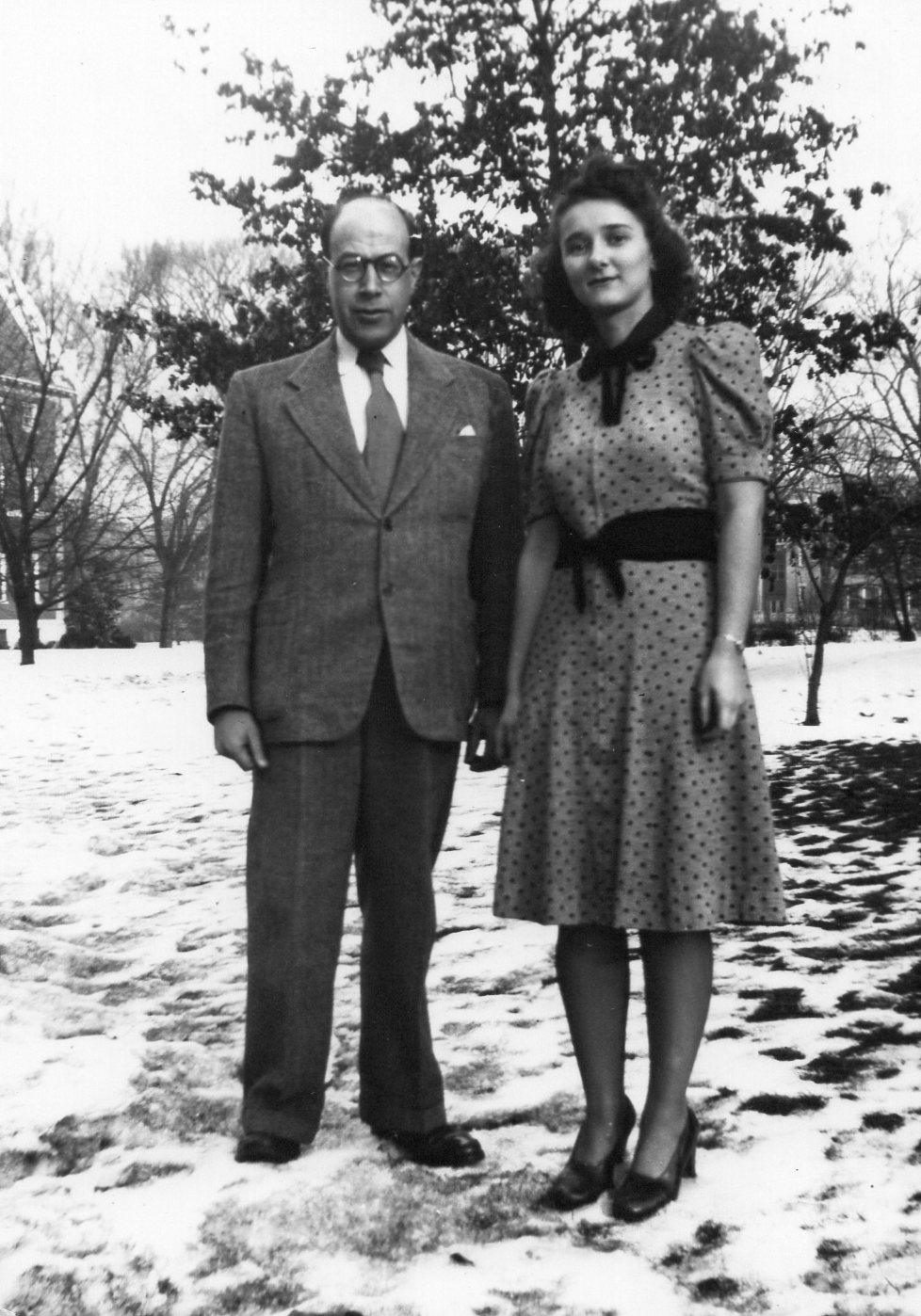
Mary (Kranos) Rubio and Professor Rodríguez Fabregat outside Lincoln Hall. She notes that it was difficult to buy a camera during wartime, and film was rationed. Enrique Rodríguez Fabregat was a Visiting Professor from Uruguay. He subsequently lived in New York City where he broadcast a regular CBS short-wave weekly program to South America, "Habla Rodríguez Fabregat."
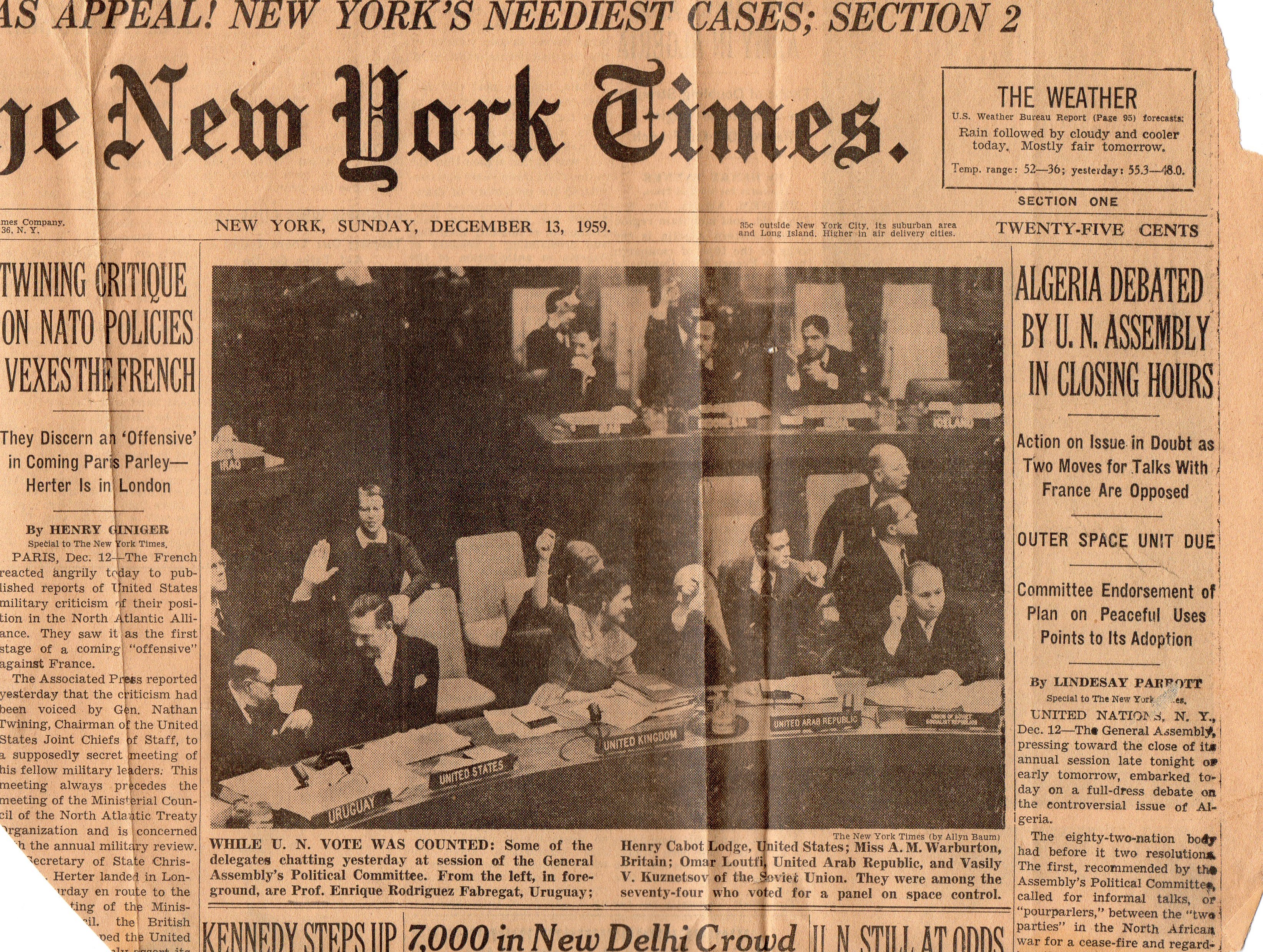 Front page from The New York Times on 12/13/59, with a photograph of Professor Rodríguez Fabregat, sitting side by side with Henry Cabot Lodge as delegates to the United Nations (they were seated alphabetically: Uruguay, United States). Each has one arm uplifted in voting.
Front page from The New York Times on 12/13/59, with a photograph of Professor Rodríguez Fabregat, sitting side by side with Henry Cabot Lodge as delegates to the United Nations (they were seated alphabetically: Uruguay, United States). Each has one arm uplifted in voting.
This is the tale of an ancient phonograph recording, autographed by the speaker, the only copy. During World War II, the department was assigned a group of enlisted men for special oral training in Spanish. The department was supplied a 78-rpm phonograph recording machine and 7-inch discs, acetate coated on glass, marked "Howard" and "Silvertone." The phonograph player wasn't new technology during the war, but the home-recording device in the department was. Mary (Kranos) Rubio, secretary to the head of the department, was in charge of the equipment and its use; these early recordings are gleeful experimentations with this new technology. She had her doubts about the technology and its implementation; she wrote on one of the records: "De Guatemala en guate-peor" (that is, from bad to worse). As she notes, "the records were GLASS BASED because of wartime restrictions. I do not remember what we used for needles. But I can tell you that at the Union Building (on the Quadrangle) at that time I was on the student music committee for providing regular recorded music in the then-General Lounge. We were under wartime restrictions which led at one point to using CACTUS needles. We even used a special sharpener, similar to a hand-held pencil sharpener".
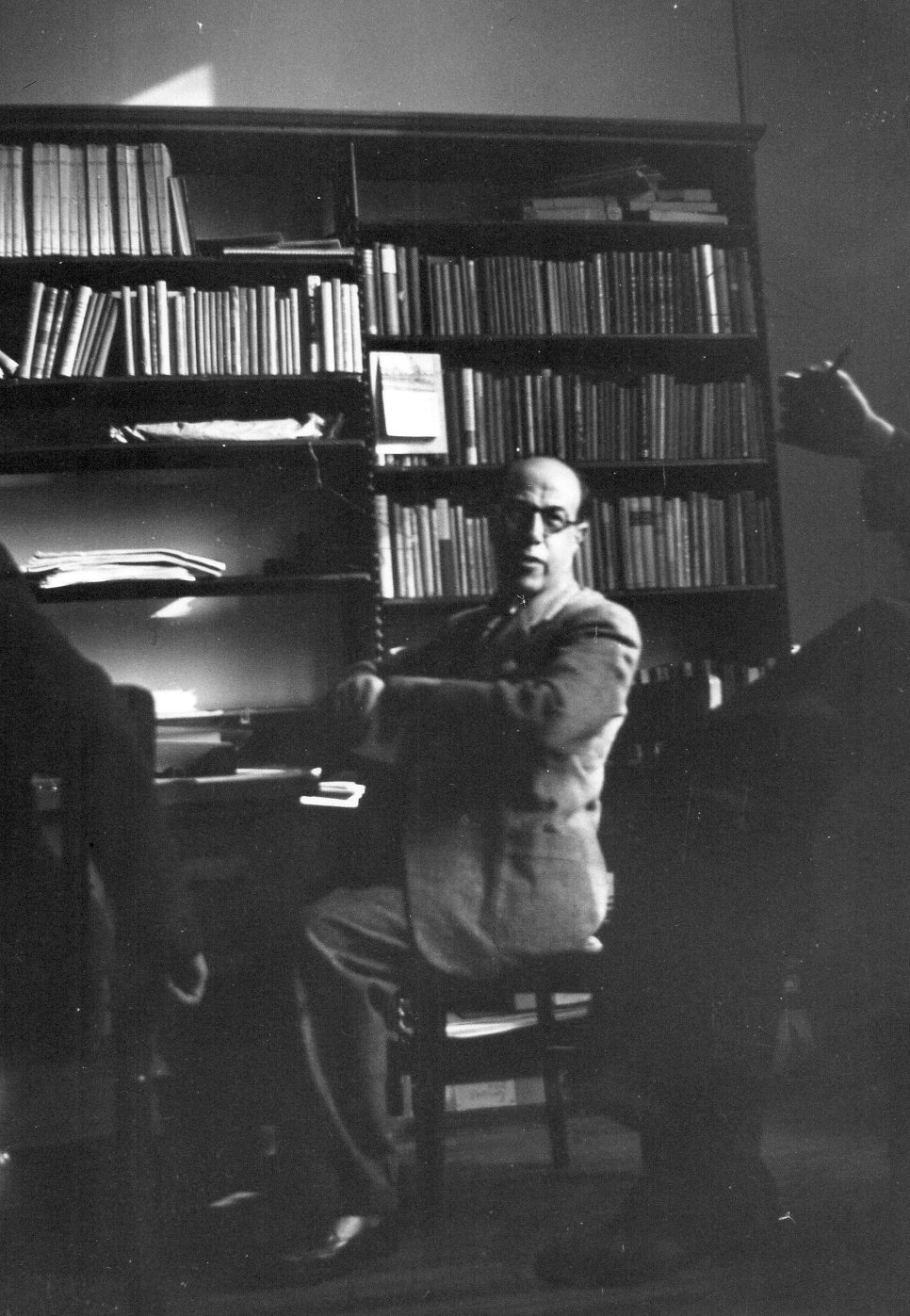 Track 1: Professor Rodríguez Fabregat is talking about why he came to Illinois to study Abraham Lincoln. He refers to Renato Rosaldo, a graduate student from Mexico who taught classes as well, and Mercedes Kahlert, a fellow student of Mary (Kranos) Rubio. (Transcription by Thalia Rubio)
Track 1: Professor Rodríguez Fabregat is talking about why he came to Illinois to study Abraham Lincoln. He refers to Renato Rosaldo, a graduate student from Mexico who taught classes as well, and Mercedes Kahlert, a fellow student of Mary (Kranos) Rubio. (Transcription by Thalia Rubio)
"Quería ver a Lincoln. Para verlo, vine a los Estados Unidos. Para encontrarlo definitivamente. Desde la raíz de su presencia y su gloria, vine a la Universidad de Illinois. Y anduve los caminos de Lincoln. La vida me ha dado esta aventura. Yo Ie agradezco a la vida que me haya permitido realizar este profundo deseo. Yo necesitaba ver a Lincoln, bajo el horizonte mismo de su pasión y su grandeza. Necesitaba sorprenderlo en el emocionado recuerdo de su pueblo, sobre esta lIanura que él recorrió. En los mismos bosques en que él descargaba con fuerzas de titán su hacha de leñador. En los mismos ríos por donde cruzó su nave, rumbo alguna vez a su destino. Yo quería verlo en Illinois, en Kentucky, en Indiana. Quería ver el lugar donde nació. Quería ver el lugar donde reposa. La excursión fue larga. EI viaje fue muy bello. Y tiene para mí todos los caracteres de lo inolvidable. Y más inolvidable aún porque yo salí desde esta Universidad de Illinois en la que hice el centro, en compañía de mi colega y mi amigo el Profesor Renato Rosaldo. Nos fuimos en su coche y con su bondad, rumbo al horizonte, y transpusimos el horizonte de magia de la vida de Lincoln. Y lIegamos hasta el lugar donde él naciera, y lIegamos hasta los lugares donde los suyos reposan. Y lIegamos hasta la iluminada estampa de donde él partiera un día rumbo a su martirio, que era como ir rumbo a su inmortalidad y su gloria. ¿Por qué el hombre del sur de América, por qué el hombre del pequeño Uruguay quiere ver a Lincoln, el hombre de los Estados Unidos? Porque él es la expresión caudal de nuestra América. De las democracias de nuestra América, de la justicia social de nuestra América, de este mismo credo y esta misma fe que los americanos lIevan hoy con su denuedo a todas las trincheras del mundo para evitar que una nueva esclavitud venga a estrangular con ignominia los derechos del hombre en los días atormentados de nuestro tiempo. Yo encontré a Lincoln en mi humildad. Yo lo amo en mi fervor. El libro de toda esta andanza está casi pronto. Otra moza de la Universidad de Illinois, la señorita Mercedes Kahlert, pondrá este Iibro mío castellano en el inglés al que va dirigido. Y entonces si yo he dado de mí un solo sentimiento de grandeza frente a Lincoln, yo Io entrego a la grandeza y la gloria de los Estados Unidos en la Universidad de Illinois."
Track 2: Professor Rodríguez Fabregat reads the following poems: "Madrigal" by Luis Urbina; "En paz" by Amado
Nervo; and "EI despertar" by Julio Herrera y Reissig.
Track 3: Professor Rodríguez Fabregat reads "Nocturno" by José Asunción Silva, "que creó un etapa en la Iírica
continental."